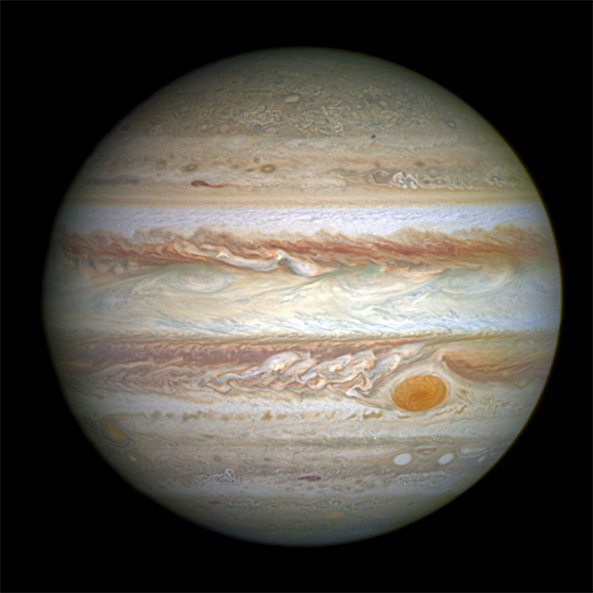RiskVA
“Starring” Jupiter and Venus 3 Dec 2008
Two very bright “stars” in the southwest evening sky have been putting on a spectacular show over the past several weeks. Not stars at all, these two heavenly bodies are the planets Jupiter and Venus.
Jupiter, The King of Planets
The highest of the two until recently, is Jupiter. But, Jupiter has been slowly catching up with Venus and tonight the two planets are very close together, with Venus slightly above Jupiter. A pair of 7-power (or higher) binoculars braced against a tree, tripod, or the side of the house will make it easy to see three of Jupiter’s moons, Ganymede, Io, and Europa. They look like bright little stars. Ganymede will be above and to the left of Jupiter, with Io and Europa below and to the right. Get out your binoculars and give it a try!
A small backyard telescope will show dark bands of clouds across the planet’s surface. A larger scope may make it possible for you to see the “Great Red Spot,” a huge 7,200 by 15,000 mile, semi-permanent storm that has been raging on the planet’s surface for at least 300 years. If you think we have violent storms on Earth, Jupiter has almost continuous ones with wind speeds over 400 mph and violent lightning lashing its surface.
A gigantic planet, Jupiter is twice as massive as all the other planets combined, and 318 times the density of Earth. It is 89,000 miles in diameter, compared to Earth’s mere 7,900! Think of Jupiter as a basketball and Earth as a grape to get a better perspective!
Jupiter’s great mass draws comets, asteroids, meteors and other space objects which otherwise might strike Earth. Without Jupiter’s protection, Earth might have been struck more often by meteors or asteroids the size of the one theorized to have caused the extinction of the dinosaurs.
Jupiter is the Roman name for the Greek god Zeus, who was king of all the gods. It is a fitting name for this greatest of all the planets in our solar system.
The planet’s atmosphere is composed mostly of hydrogen (about 90%) with the remaining 10% being helium. There are also traces of methane and ammonia. You wouldn’t want to breathe the air there! It probably has a dense, rocky core, 10 15 times the mass of the earth. Because of its tremendous gravity, Jupiter’s hydrogen, near the core, is likely in a liquid, metallic form.
Daytime on Jupiter lasts only about 9 hours, but the clouds are so dense that the sun’s light never reaches the surface.
Venus, The Beautiful
Named after the Roman goddess of love and beauty, Venus may have received that title because it was the brightest “star” in their night sky. This fall, it is also the brightest object in our early evening western sky.
Shortly after the sun sets, the planet Venus is now very low in the west, and so bright that some folks have called local TV news stations to ask about the “strange white light” in the sky. Each year Venus is mistaken for the space shuttle, the International Space Station, a weather or hot-air balloon, or a UFO. But, the shuttle and the ISS would move rapidly across the sky, not remain stationary. So would other artificial satellites. Venus’ motion is almost imperceptible as it slowly sets. And UFOs? Well who knows what they might do!
About 7,500 miles in diameter, Venus is about the same size as Earth, but what a difference! Its atmosphere is almost all carbon dioxide, and the pressure at its surface is 90 times that of Earth, or about the same as half a mile under the ocean! Although its surface is similar in composition to Earth, its temperature is often hot enough to melt lead! It may be beautiful to view from Earth’s remote location, but a personal visit would be a little rough. East Texas summers would seem icy in comparison. A Venusian day lasts 243 of our Earth days. Long day at work! Daylight on Venus is about the same as a completely overcast day on Earth. Even with the tremendous heat, weather on Venus is far less violent than that of Jupiter. Winds on its surface are gentle.
Venus, viewed through good binoculars or a small telescope, has phases like our moon. If you observe it with binoculars tonight it will be about two-thirds full.
As winter comes on, the sky will fill with the brightest and most beautiful of our stars and constellations. I will be filling you in on them later. In the meantime, take time to get outside and enjoy the developing spectacle.
Dr. Risk is a professor emeritus in the College of Forestry and Agriculture at Stephen F. Austin State University in Nacogdoches, Texas. Content © Paul H. Risk, Ph.D. All rights reserved, except where otherwise noted. Click paulrisk2@gmail.com to send questions, comments, or request permission for use.


